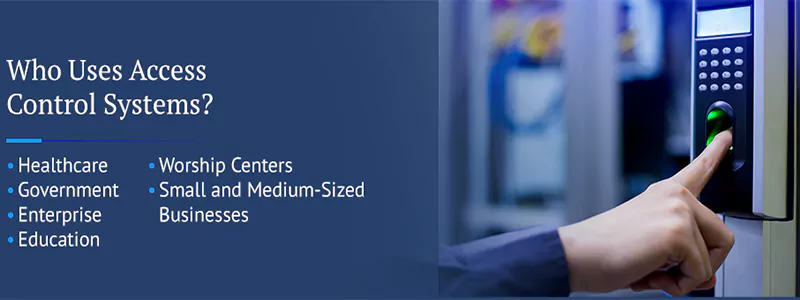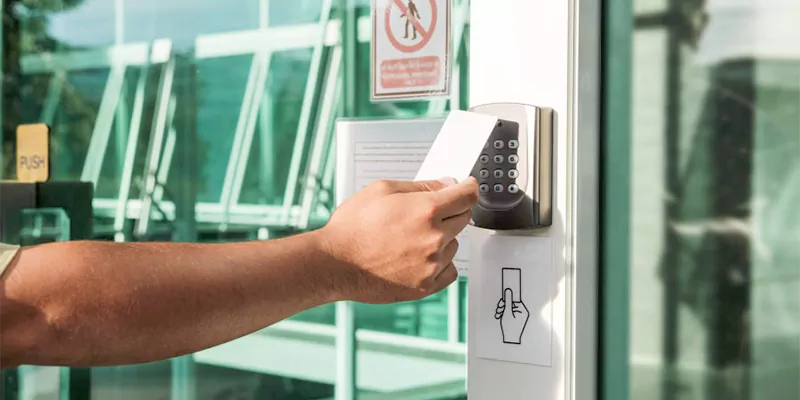Purpose of an Access Control System
An access control system establishes who may access specific spaces or resources, at what times, and under which conditions, transforming doors, cabinets, gates, and server enclosures into governed endpoints. Its purpose extends far beyond opening locks. It safeguards people and assets, proves compliance, reduces operational friction, and converts daily movement into actionable security intelligence. When implemented well, access control becomes the backbone of a broader risk program, aligning physical protections with IT security, HR processes, and safety procedures across offices, campuses, factories, and critical outdoor sites.

What an Access Control System Really Does
At its core, an access control system links identity to authorization. A user presents a credential, the system authenticates it, evaluates policy in real time, and executes an action such as releasing a strike, unlocking a smart lock, enabling an elevator floor, or opening a turnstile. Each decision is logged with timestamps, location, door state, and reason codes. This reliable, tamper-resistant record supports audits, investigations, and continuous improvement. Because policies are centralized, updates propagate instantly: when roles change, projects end, or risks rise, permissions adapt without manual rekeying or site-by-site configuration.
Core Purposes: Security, Compliance, and Efficiency
SecurityComplianceOperations The primary purposes of access control are threefold. First, it prevents unauthorized entry to sensitive areas by enforcing least-privilege access, mitigating theft, tampering, espionage, and sabotage. Second, it enables organizations to prove adherence to regulations and internal policies through provable logs, granular permissions, and retention controls. Third, it streamlines operations: onboarding is faster, visitor flows are smoother, and emergency procedures can be automated. Together these purposes create a safer, more predictable, and more cost-effective environment.
From Keys to Identities: Why This Shift Matters
Physical keys are hard to track and expensive to reissue. Once copied or lost, risk persists until every cylinder is replaced. Identity-centric access control eliminates that brittleness. Permissions follow people and roles instead of metal keys. If a contractor’s work ends at 6 p.m., the credential stops at 6 p.m. If a laptop cabinet requires two people for access, the system enforces dual authorization. If a lab demands weekend restrictions, a schedule applies automatically. These identity-driven rules shrink risk windows while keeping day-to-day work fluid.
Physical Controls that Protect Digital Assets
Cybersecurity often fails when physical boundaries are weak. Protecting network closets, server rooms, telecom cabinets, and media safes is as vital as patching systems and rotating secrets. Access control complements zero-trust architectures by limiting physical exposure to critical systems and correlating events with IT logs. If a user logs in remotely while their badge never entered the building, the discrepancy triggers review. If multiple denied attempts precede a privileged system action, security can investigate the physical path, not only the digital one.
Compliance, Audit, and Governance
Standards and regulations expect demonstrable control over restricted spaces and sensitive records. Modern access control produces immutable histories that capture every grant, denial, override, and configuration change. Retention policies ensure records exist for the required period, and role-based administration constrains who can change what. During audits, security teams export reports by door, area, user, or time window, cross-reference with HR events, and validate chain-of-custody for anything from pharmaceuticals to removable drives. This auditability turns compliance from a scramble into routine reporting.
Operational Excellence and Cost Reduction
Access control reduces friction across the whole lifecycle of a workplace. HR onboarding triggers role-based permissions automatically. Facilities avoid constant key cutting, rekeying, and ad hoc escorting. Multi-site companies monitor door health, battery status, and connectivity from a single console, prioritizing maintenance before failures occur. Visitor kiosks minimize lobby congestion and issue mobile passes within seconds. Over time, the organization shifts away from reactive fixes toward predictable, data-driven operations with fewer truck rolls, fewer incidents, and clearer accountability.
Safety, Emergencies, and Life-Safety Codes
Well-designed systems balance security with life-safety. Fail-safe or fail-secure behaviors align to building codes so egress is always possible during fire events, while lockdowns can be zoned during threats. Playbooks define which doors unlock or lock, who gets notified, and how logs are bookmarked for after-action review. Muster reporting shows who likely remains inside based on recent access events, aiding responders. Post-incident analytics identify gaps so procedures improve rather than repeat.
Components: How the Pieces Fit Together
1. Credentials & Factors
Cards, fobs, PINs, mobile credentials, biometrics, and one-time codes. Often combined for multi-factor assurance where risk is higher.
2. Readers & Sensors
Card/mobile readers, keypads, biometric scanners, door contacts, request-to-exit sensors, and turnstile inputs define the access boundary.
3. Controllers & Smart Locks
Door controllers and edge devices enforce policy locally, continue operating during outages, and synchronize decisions when connectivity returns.
4. Management Software
Cloud or on-prem platforms set policies, roles, schedules, anti-passback, and alarms; integrate with HRIS, directory services, VMS, and SIEM.
5. Logging & Reporting
Immutable event streams with time, user, door, outcome, and reason codes power audits, KPIs, investigations, and compliance exports.
Policy Models: RBAC, ABAC, and PBAC
Role-Based Access Control (RBAC) assigns permissions by job function and location, simplifying large deployments. Attribute-Based Access Control (ABAC) adds context such as time of day, project tag, or risk level, enabling nuanced decisions. Policy-Based Access Control (PBAC) externalizes logic into human-readable rules that security and compliance teams can review. Most organizations blend these models, using RBAC for the baseline, ABAC for context, and PBAC for clarity and governance.
Authentication Factors and Assurance Levels
Not every door needs biometrics, and not every file room should rely on a single factor. Assurance scales with risk. Low-risk areas might permit card-only authentication. Server cages might require card plus PIN or card plus biometric. Critical enclosures might require dual-person approval, where two distinct identities must be present within a short interval. By mapping factors to data sensitivity and hazard levels, organizations spend where it counts and keep routine movement frictionless.
Credential Types: Strengths and Trade-offs
Cards and fobs are inexpensive and fast but can be shared if not paired with PIN or biometric checks. Mobile credentials reduce issuance friction, support revocation at distance, and enable phishing-resistant cryptography when implemented with device secure elements. Biometrics eliminate sharing but demand careful privacy handling, consent records, and spoof resistance. Temporary and one-time credentials enable vendor access without creating long-lived risk. A balanced mix aligned to risk yields the best outcome.
Deployment Models: Cloud, On-Prem, and Hybrid
Cloud management speeds deployment, simplifies updates, and supports multi-site oversight with minimal infrastructure. On-prem deployments suit ultra-isolated networks and bespoke compliance requirements, but demand more maintenance. Hybrid approaches keep decision-making at the edge while leveraging cloud for visibility, analytics, and integrations. Whichever model you choose, ensure controllers can operate offline and that backups, firmware signing, and configuration baselines are part of the plan.
Integrations that Multiply Value
Access control gains power when integrated. Video Management Systems (VMS) provide visual context for events and alarms. Security Information and Event Management (SIEM) tools correlate physical and logical anomalies. HRIS and identity directories automate onboarding and offboarding. Workplace tools schedule room permissions, while ticketing systems turn alarms into accountable tasks. These integrations unify your security posture and minimize swivel-chair operations for staff.
Advanced Features that Reduce Real-World Risk
Anti-passback prevents a card from re-entering without first exiting, limiting credential sharing. Tailgating detection pairs sensors and analytics to flag piggybacking. Interlocks ensure only one door in a vestibule opens at a time. Mantraps protect high-security rooms. Threat-level switching shifts the entire policy set when the risk posture changes. These features transform a simple door system into a responsive, risk-aware control plane.
Visitor, Vendor, and Temporary Access
Modern visitor flows begin before arrival. Guests pre-register, upload IDs where policy requires, sign NDAs digitally, and receive QR or mobile passes. When they arrive, kiosks verify identity and print badges with photo and access zones. Vendor access is constrained to doors, racks, or cabinets tied to work orders and expiring at defined times. These self-service, policy-driven flows keep lobbies moving while preserving strong security.
Metrics and KPIs for Continuous Improvement
1. Denial Rate by Door
High rates may indicate misconfigured schedules, broken hardware, or attempted misuse that needs investigation.
2. Unassigned Credential Ratio
Measures hygiene in card and mobile issuance; a growing ratio suggests stale inventory or process gaps.
3. Time-to-Revoke
Tracks how quickly access is removed after role changes or offboarding, a critical insider-risk metric.
4. Alarm Mean Time to Acknowledge
Shows responsiveness of operators and the usability of your dashboards and runbooks.
5. Maintenance Backlog
Reveals systemic issues with batteries, readers, and controllers before they cause downtime.

Implementation Roadmap
1. Discovery and Risk Mapping
Inventory spaces, assets, and processes. Rank areas by sensitivity and hazard. Identify user groups, shift patterns, and emergency needs. Document regulations and record-retention requirements. This map becomes the blueprint for policy and factor selection.
2. Policy and Architecture Design
Define roles, attributes, schedules, and escalation paths. Choose cloud, on-prem, or hybrid management. Select controllers and smart locks that meet environmental demands, including outdoor enclosures or explosion-proof ratings where needed. Plan for offline operation and encrypted communications end to end.
3. Pilot and User Experience Tuning
Start in one building or wing. Validate badge and mobile issuance, visitor flow, and alarm handling. Train reception and security staff. Collect feedback to polish friction points before scaling. Measure KPIs to establish your baseline.
4. Scale-Out and Integration
Expand site by site with a repeatable playbook. Integrate with HRIS, directory, VMS, SIEM, and ticketing systems. Set up automated reports for compliance and executive visibility. Harden backups and firmware upgrade procedures.
5. Operate, Audit, and Improve
Run quarterly reviews of roles, schedules, contractor lists, and stale credentials. Test emergency playbooks. Tune alarms to reduce noise. Publish KPI dashboards. As the workplace evolves, adjust policies rather than bolt on exceptions.
Cost Considerations and Total Cost of Ownership
Budget spans hardware (controllers, locks, readers, sensors), software licenses or subscriptions, installation labor, wiring, network segmentation, and ongoing maintenance. Cloud management shifts costs to predictable operating expenses and reduces server upkeep. Smart locks reduce cabling but require battery programs. The biggest hidden expense is manual work: rekeying, escorting, inconsistent visitor handling, and reactive fixes. Access control amortizes those costs by replacing them with automation and data-driven planning.
Common Pitfalls and How to Avoid Them
Projects stall when policies are vague, stakeholders are misaligned, or user experience is neglected. Avoid one-size-fits-all factor requirements that slow operations. Keep credential issuance and revocation tied to HR events. Test fail-safe behavior and fire panel interactions before go-live. Document everything from door schedules to firmware versions so handoffs and audits are smooth. Most importantly, measure outcomes with KPIs so you can prove value and justify improvements.
Best-Practice Checklist
- Map areas by risk and align factors to sensitivity rather than using a single global rule.
- Automate onboarding and offboarding through HRIS or directory integrations.
- Enable mobile credentials where practical to cut issuance delays and lost card overhead.
- Pair access control with VMS to add visual verification for alarms and investigations.
- Drill emergency scenarios and verify fail-safe and lockdown behaviors regularly.
- Set quarterly reviews for roles, schedules, and stale credentials; close gaps promptly.
- Protect privacy by minimizing biometric storage, applying consent, and encrypting at rest and in transit.
- Track KPIs such as denial rates, time-to-revoke, and alarm acknowledgement to drive continuous improvement.
Mini Case Studies
Global Tech Campus
A multinational unified physical access across five regions using cloud management and mobile credentials. HR-driven automation cut onboarding time from days to minutes, while tailgating analytics reduced unauthorized piggybacking at executive floors by more than half. Quarterly audits now finish in hours instead of weeks because reports consolidate across all sites.
Hospital and Pharmacy Chain
A healthcare group segmented public corridors from medication rooms and labs with two-factor controls during dosing hours. Visitor kiosks accelerated patient family check-ins while preserving privacy. The pharmacy chain adopted expiring vendor credentials, eliminating after-hours access drift across dozens of locations. Compliance reporting moved from manual spreadsheets to scheduled exports tied to policy IDs.
Utilities and Field Cabinets
A utility deployed rugged smart locks and offline-capable controllers at remote substations and telecom cabinets. GPS-tagged events synchronized when crews returned to coverage. Dual-approval rules for critical switching cabinets reduced single-operator risk. Battery health telemetry prevented field outages and cut emergency dispatches considerably.
Glossary
1. RBAC
Role-Based Access Control, where permissions derive from job roles and locations.
2. ABAC
Attribute-Based Access Control, where context like time, project, and risk influence decisions.
3. Anti-Passback
Rule preventing re-entry without exiting first, limiting credential sharing.
4. Fail-Safe / Fail-Secure
Door behavior under power loss; fail-safe unlocks for egress, fail-secure remains locked.
5. Mantrap / Interlock
Two-door vestibule where only one door opens at a time to protect high-security areas.

Conclusion
The purpose of an access control system is to translate organizational intent into consistent, auditable, and user-friendly protections. It keeps the wrong people out and the right people moving, proves compliance without heroics, and surfaces data that improves decisions. When aligned with cyber controls, HR processes, and safety plans, access control becomes the quiet backbone of a resilient workplace. Rather than a collection of doors, you gain a coherent security fabric that adapts to change while staying simple to operate.
Frequently Asked Questions (FAQs)
1) How is an access control system different from traditional keys?
Traditional keys cannot express policy. They cannot expire automatically, adapt to schedules, or record usage. An access control system binds permissions to identities, enforces context such as time and zone, and records every event. When roles change, permissions change instantly without rekeying, reducing cost and risk while improving accountability.
2) Do small businesses really need access control?
Yes. Even a small office benefits from revocable mobile or card credentials, visitor self-service, and audit-ready logs. Lightweight, cloud-managed options keep costs down while eliminating the hidden expenses of lost keys, rekeying, and ad hoc escorting. Starting small with a few critical doors is a practical path that scales later.
3) What happens during a power or network outage?
Door controllers and smart locks continue enforcing the last known policy while offline. Fail-safe or fail-secure behaviors align to life-safety requirements. When power or connectivity returns, buffered events synchronize to the server. A good design includes UPS on critical panels and clear runbooks for facilities and security teams.
4) Which authentication factors should we choose?
Align factors to risk. Use card or mobile-only for low-sensitivity areas, add PIN or biometric for server rooms and drug cabinets, and apply dual-approval for critical enclosures. Mobile credentials reduce issuance delays, while biometrics remove sharing at the cost of stricter privacy controls. Audit and tune as the environment evolves.
5) How does access control support compliance?
It provides immutable logs and granular policies that demonstrate only authorized personnel entered protected areas during defined windows. Scheduled reports and retention rules align to frameworks like ISO 27001 and healthcare privacy standards. During audits, exporting door-by-door histories and policy references turns evidence gathering into a routine task.
6) Can access control reduce operating costs?
Yes. Automating onboarding and visitor flows, eliminating rekeying, and monitoring device health saves labor and avoids downtime. Centralized management reduces site visits, and analytics focus maintenance where it is needed most. Over time, predictable processes replace costly emergencies.
7) What are anti-passback and tailgating detection?
Anti-passback prevents re-entry without a corresponding exit, discouraging card sharing. Tailgating detection uses sensors, analytics, or camera integration to flag piggybacking events where multiple people follow on a single authorization. Both reduce the risk of unauthorized presence inside secured zones.
8) How do we protect privacy with biometrics?
Minimize data by storing templates rather than raw images, encrypt at rest and in transit, and restrict administrative access. Collect user consent where required and provide transparent retention and deletion policies. Use biometrics only where risk justifies them, pairing with strong governance and regular reviews.
9) What is the best way to start a modernization project?
Begin with discovery and risk mapping, then pilot in one building. Prove user experience, integrations, and emergency behaviors before scaling. Set KPIs like time-to-revoke and denial rate to measure progress. Document runbooks so operations stay consistent as you expand site by site.
10) How often should policies and permissions be reviewed?
Quarterly reviews catch drift in roles, schedules, and contractor lists. Trigger immediate reviews after reorgs, major incidents, or audit findings. Automated reports can highlight stale credentials, unusual denial patterns, or areas with weak factor coverage so teams can act before issues escalate.
Try Vanma Electronic Lock
You can contact us to request samples, and to experience the convenience of Vanma electronic locks.
Contact Us NowMeet Your Security Needs Today
We offer the most appropriate guard tour systems for users around the world. For guard managing, reporting, and tracking. Any problem, contact us!

